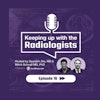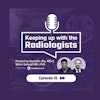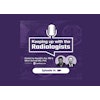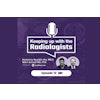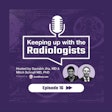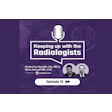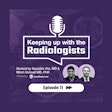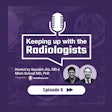AuntMinnie.com · What's next for chest radiographs? Episode 9 Keeping Up With The Radiologists
The chest radiograph remains the most commonly performed imaging exam worldwide. But what does the future hold?
In Episode 9 of Keeping Up With the Radiologists, the conversation takes listeners from the early days of chest x-rays to a discussion on its current value. The best segments of the podcast may very well be, however, on where AI technology vendors are still struggling -- and "mightily," according to Mitchell Schnall, MD, PhD.
As many regular Keeping up with the Radiologists podcast listeners already know, Schnall leads large-scale technology strategy as senior vice president for data and technology solutions for the University of Pennsylvania Health System (UPHS). He's the person spearheading the health system’s efforts to understand new tools and approaches and determine how best to implement them across UPHS to improve the provider experience, boost health outcomes for patients, and drive efficiency across the health system.
Schnall with fellow radiologist Saurabh (Harry) Jha, MD, welcome to the discussion Warren Gefter, MD, professor emeritus and long-time section chief of chest radiology (ret.) at the University of Pennsylvania. The trio takes turns rationalizing key questions facing radiologists and hospital and health system leaders.
For those only present- and future-focused, the radiologists won't wax long romanticizing the past, but Schnall made one very important point that's especially thought-provoking.
"It would be valuable to get back to where we have the time to serve as real physicians, as consultants," Schnall said. "That unique ability to use the chest radiograph as a catalyst to engaging in all of the patient history and all of the other findings in the patient and coming up with the diagnosis, many times not necessarily using specific information from the chest radiograph, was just a unique feature of the chest radiologist back in the day."
"Every imaging exam is the opening for a radiologist to consult on the patient with the radiology study as the window into the patient." — Mitchell Schnall, MD, PhD, Penn Medicine, University of Pennsylvania Health System
Special guest Gefter, a Fleischner Society member known for his research work in hyperpolarized helium and many facets of chest imaging, now focuses on AI in chest imaging.
"We can't just look at [AI] as just a detector," Gefter said. "We have to look at it as something that can integrate all the clinical data and come up with a coherent picture and diagnoses."
If AI were listening, it might need to know that pulmonary medicine is not just about the lungs. It's all about the systemic diseases that can create anarchy in the lungs, Jha pointed out. If radiologists and subspecialists need to have a good knowledge of systemic disease, it would make sense that AI might need better training on that as well.
"Clinicians used to use imaging with much more contextual background than they do now," Gefter continued.
Some possessed deep knowledge, were especially perceptive, and were accurate in their interpretation too. However, "the breadth of the possibilities unleashed by cross-sectional imaging has made it more difficult for us to home in," Gefter said.
"High-quality 3D imaging really provided a much clearer path to diagnosis," Schnall said. "At the same time what we saw is we still used the plain radiographs, but the context on which those radiographs are being used -- and the same is true in other fields besides chest -- has really shifted. We don't rely on them anymore. We still are using radiographs but largely for different things." Hear more inside.
Because of the overwhelming amount of data, both on a CT study plus the increasing burden currently of the workload, there is simply not sufficient time to try to get the necessary clinical information, Gefter explained, adding that the current problem with electronic health record (EHR) software is that radiologists don't have a streamlined way to query the targeted information that they need.
"I have no doubt that that is going to change," Schnall said, reflecting on his new role at UPHS. "Like many institutions, we've created our own cloud. We have ChatGPT 4.0 in the cloud. It doesn't have any serious interface yet to our record, but people are becoming the experts of prompt engineering ... what questions you ask. We're going to see a much more facile ability to extract data much more efficiently from the record in a much more effective way, and that's going to happen relatively soon."
What's next for chest radiography?
You might remember hearing about "human AI-symbiosis" back in January and a paper Gefter led with Curt Langlotz, MD, PhD, from Stanford University and others. AuntMinnie.com editor Will Morton interviewed Gefter after that paper was published.
The paper posited that deep learning, large language models, and multimodal vision-language foundation models have positioned AI to transform chest radiography. The podcast follows up on the notion of endorsing AI for chest radiographs, in principle Jha added, and keeping radiologists "in the loop." But what is the meaning of in the loop and how might in the loop come to be redefined?
Gefter takes us through how he envisions AI in the radiologist's workflow for the chest radiograph. This is where the talk turns to autonomous readings. A statement in the paper may help to set the stage.
"The urge for autonomy comes from a fundamental misunderstanding of what radiologists do." — From Human-AI Symbiosis: A Path Forward to Improve Chest Radiography and the Role of Radiologists in Patient Care
"There are narrow autonomous uses of AI which are probably inevitable," Gefter explained.
Perhaps more of interest is where vendors are in making their AI business cases. "Without some level of autonomy, or some level of being able to replace effort that otherwise a human is putting into, there's not going to be a sustainable business model and in fact that's where we are now," Schnall said.
"The algorithms aren't quite good enough to operate autonomously so what could they provide value where they can tolerate errors," Schnall added.
One that has been suggested is list prioritization, but the problem is alarms that aren't alarm-worthy to radiologists, according to Schnall. Another is opportunistic screening, but the premise of "making money" on extra procedures doesn't make a broad enough business case. The third is AI as co-pilot to the radiologist.
"How is it being used and what are we asking of the chest x-ray in today's world compared to what we used to ask?" Schnall asked. "Every year the number of x-rays are in excess of the number of providers we have to read them. We're in an unsustainable trajectory."
Right now, the idea of adding a radiologist co-pilot would be burdensome, Schnall said.
Chest x-ray is still the most commonly performed imaging examination worldwide, according to the panel. It's also one of the leading causes of medical malpractice claims, according to Gefter. Perhaps the answer is finding the best use for low-cost, low-dose CT. Listen now.
More impressions:
{01:37:11} Lookback
{08:14:09} Master radiologists
{13:34:06} Systemic diseases
{16:24:21} Cross-sectional imaging
{41:38:07} Volume of chest x-rays
{44:38:27} FDA AI approvals and chest x-rays
{45:58:26} Estimate of chest radiographic findings
{46:53:16} Thoracic disorders, training data
{48:23:09} Multimodal large language models
{48:57:07} Foundation models
{50:49:15} Radiologists in the loop
{51:26:02} Quality control (QC) processes
{58:11:00} Lines and tubes, aeration
{33:37:02} Problem with predictive algorithms
{01:08:17:06} Collaborative workflows
Guest: Warren Gefter, MD, is a diagnostic radiology specialist who served as a long-time section chief of chest radiology at the University of Pennsylvania.
Hosts: Saurabh (Harry) Jha, MD, is an associate professor of radiology at the Hospital of the University of Pennsylvania. Jha obtained a master’s degree in health policy research from the Leonard Davis Institute at the University of Pennsylvania. He earned his medical degree from the United Medical and Dental Schools of Guy’s, King’s, and St. Thomas’ Hospitals. Jha developed Value of Imaging, a set of radiology educational resources.
Mitchell Schnall, MD, PhD, is a physician at Penn Medicine in its abdominal imaging services program. Schnall served as chair of the department of radiology and the Eugene P. Pendergrass Professor of Radiology at the Perelman School of Medicine, before taking on the role of senior vice president for data and technology solutions for the University of Pennsylvania Health System in 2024. Schnall still serves as group co-chair of the ECOG-ACRIN Cancer Research Group since its founding in 2012. He is an international leader in translational biomedical and imaging research, working throughout his career across the interface between basic imaging science and clinical medicine to ensure effective integration of radiology research with other medical disciplines.
This episode of Keeping Up With the Radiologists is brought to you by AuntMinnie.com in collaboration with Penn Radiology. The series is also available on Spotify, YouTube Music, and Apple Podcasts. Check back for new episodes!

